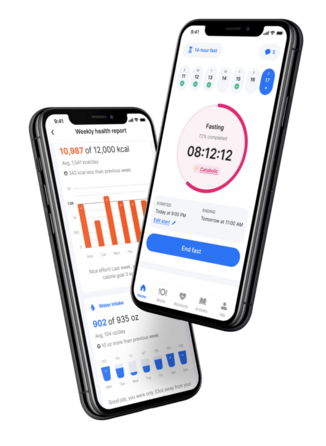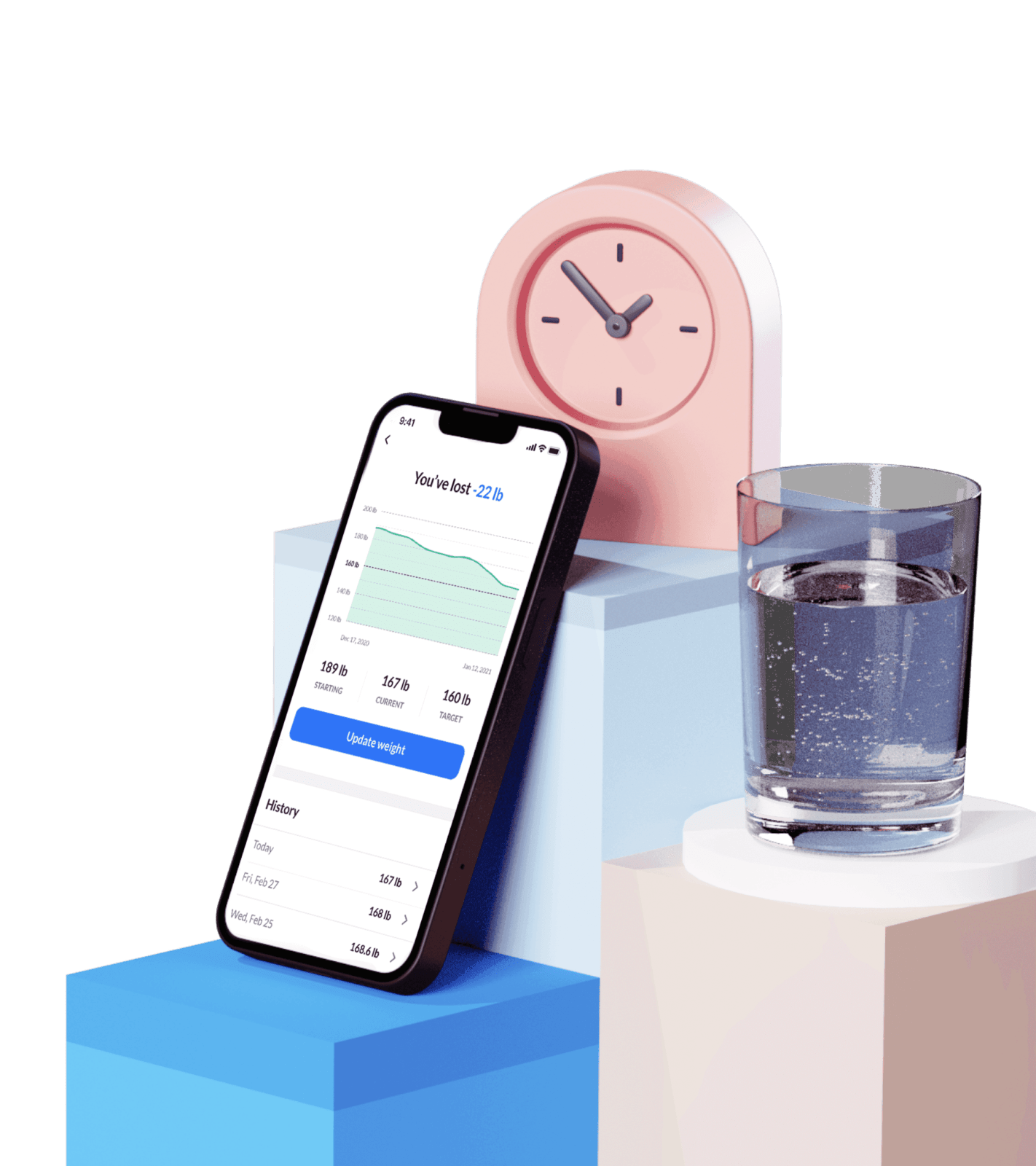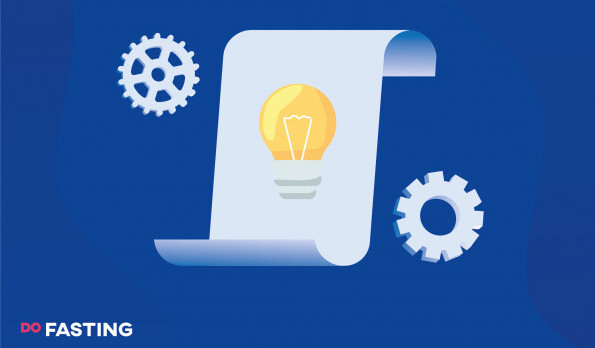Contents
Is It Safe to Exercise While Fasting?
Yes, it’s entirely safe to exercise during a fast. In fact, exercising on an empty stomach can encourage your body to burn fat for energy rather than muscle, which won’t make you feel weak.
Exercise between fasting periods can also be beneficial, but it will only help you burn the calories from the food you’ve eaten rather than stored fat. Consider working out in the morning while fasting for the most noticeable weight loss results.
Some other benefits of exercising during a fast include:
- Faster weight loss — cardio-based exercises or weight training while fasting can help you lose fat quickly, as fasting depletes any glycogen stores, giving your body no choice but to burn fat.
- Looking and feeling healthier for longer — of course, it’s no shock that exercise makes you feel great. Research shows that exercise increases blood flow to the brain, leading to better concentration, moods, and energy throughout the day.
- Increasing autophagy — exercise-induced autophagy means your body eliminates damaged cells while you work out. Over time, you’ll have a lower risk of oxidative stress—an imbalance of free radicals and antioxidants.
Take a
1-minute quiz
and discover how much weight you can lose with DoFasting!

6 Tips for Optimal Workout Results During Fasting
There are certain things you can do to boost your exercise performance during fasting—which, as a plus, will be especially beneficial if you’re looking to maintain muscle mass while losing weight.
Write down these 6 tips and don’t miss a single workout.
1. Choose your fasting type according to your goal
Before starting an exercise routine while fasting, it’s essential to consider which type of fast best aligns with your goals. For example, a 16-hour fast involves eating for 8 hours and fasting for 16, which can help your body burn stubborn fat throughout the day, but it can be harder to stick to than a 12-hour fast.
A longer eating period—like the ones suggested in the most manageable fasting plans—might provide more energy for exercise, which can be especially important for those who need to monitor their blood pressure or blood sugar levels. But in the end, it all comes down to your preferences and whether you want to exercise during a fast or not.
If you already have more experience with fasting, an extended fast—lasting for 24 hours or longer—might also boost your results. However, you must prepare your body before training by drinking plenty of water and eating nutrient-dense foods.
2. Timing is everything
Timing is essential when it comes to achieving your goals.
According to research, eating before weightlifting can fuel your muscles and improve your performance, as food allows you to maintain a higher intensity during your workout. On the other hand, not eating could cause your muscles to feel weak and hinder your progress.
It’s also best to do cardio-based exercise during a fast, as it encourages your body to burn fat and balance your overall body composition. High-intensity interval training (HIIT) is great for people who want to see visible weight loss over a few weeks.
It’s important to note that these recommendations are not set in stone, and everyone’s goals and preferences may differ. The key is to focus on your end goal and choose exercises to help you reach it efficiently. Experiment with different approaches and see what works best for you.
3. Choose exercises according to your goal
It’s essential to plan out your exercise routine for the day to ensure that you’re getting the most out of your workouts. Going into your practice without a clear plan can lead to slower weight loss and a lack of motivation.
For example, cardio training is best for losing fat. The human body constantly burns calories to give you energy and function properly. You could go for a long-distance run outside or use some space at home to perform high-intensity workouts.
Cardio training is generally best for losing fat, as it helps your body burn calories and maintain proper function. If you want to pump up your heart, you can choose activities like long-distance running or high-intensity workouts.
We know that cardio can be challenging and uncomfortable, but it is crucial for maintaining good health and slimming down your waist. If you’re new to this type of exercise, try and start with short cardio workouts—10, 15 minutes—and add more minutes to your training as you get used to it.
On the other hand, strength training is ideal for building muscle mass. People who lift weights are more focused on muscle growth than weight loss, but this kind of exercise can be of great help when trying to drop a few pounds. You can incorporate strength training exercises for the lower and upper body into your routine, depending on your goals and how much you want to exercise while fasting.
Remember to choose exercises that align with your goals and preferences, and don’t be afraid to experiment and see what works best for you.
4. Choose the right meals after your workout
Eating specific types of food before and after exercise is key to ensuring that you have enough energy without feeling weighed down.
To prepare for a workout, you should eat a balanced meal containing carbs, protein, and fat at least two hours beforehand. This will give you fuel and allow your body to digest the nutrients properly. Some easy options include chicken wraps, rice and beans, or a turkey and avocado sandwich.
After your workout, consuming foods high in protein is essential to support muscle repair and recovery. These foods can help regulate fat and carbohydrate metabolism and give your body essential nutrients. Some examples include peanut butter, oatmeal, eggs, and grilled chicken.
Bone broth can also be a great post-workout option for those who want something light and nourishing. This soup contains nutrients like calcium, protein, phosphorus, and magnesium, and its electrolyte content can help keep your body hydrated and maintain fluid balance in your cells.
Take a
1-minute quiz
and discover how much weight you can lose with DoFasting!

5. Stay hydrated and keep your electrolytes up
Staying hydrated during intermittent fasting is crucial, especially when exercising, as sweating during your workout can cause you to lose fluids and electrolytes, leading to dehydration if not replenished. To prevent this, drink plenty of water throughout your fasting period and consider adding electrolytes to your water or other beverages.
In addition to preventing dehydration, water can help suppress your appetite, remove fat cells, and reduce visceral fat in metabolically-healthy obese adults. This makes it a vital beverage for preventing weight gain and maintaining good health.
To ensure you’re getting enough water, aim to consume the daily recommended amount for your gender: men should aim for 12 cups per day, while women should aim for 9 cups. It can be helpful to keep a water bottle nearby throughout the day to help you stay on track.
If you aren’t sure about your hydration needs, check in with your physician or registered dietitian. Medications, activity level, age, and gender are just a few of the many factors that affect our hydration status and needs.
6. Know your limits
Yes, it is possible to overdo it when exercising, especially when trying to enhance the effects of intermittent fasting. Excessive exercise can lead to many negative consequences, such as low blood sugar, chronic fatigue, headaches, dehydration, and emotional stress.
To avoid these issues, listen to your body and take breaks when needed. Rest days are crucial for muscle repair and overall recovery, and it’s generally recommended that people take 1-2 rest days per week when training regularly. Don’t feel guilty about making a pause—it’s a key part of maintaining a healthy and sustainable exercise routine. Listen to your body, and go from there.
If you are worried about consistency, you can also try finding someone to help keep you accountable or journaling.
Who Should Not Exercise During Fasting?
It’s important to note that exercise during intermittent fasting may not be suitable for everyone. If you have specific health problems or injuries, taking a more cautious approach to your training may be necessary.
Some conditions that might warrant caution include:
- Low blood sugar levels
- Serious joint problems
- Asthma
- Back pain
- Injuries
If you have any concerns about your ability to exercise during a fast, you must consult your doctor. They can help you determine the best approach for your individual needs and may suggest low-intensity exercise as an alternative to more strenuous activity. Remember: the goal is to focus on your long-term health, not to rush into workouts that could potentially worsen your condition.
Another important tip is to start slowly and gradually increase your intensity. If you’re new to exercise, try starting with daily 10-minute walks and then build up from there. Remember that everyone has a different fitness level, so it’s important to listen to your body and adjust your routine accordingly.
Train Your Way to Weight Loss With DoFasting
Exercise during intermittent fasting can be an effective way to accelerate weight loss, but it can be challenging to get started. Fortunately, the DoFasting app can provide support and guidance to help you master your fasting and workout schedules.
The app offers a variety of features, including:
- 5000+ recipes — the app’s extensive recipe library makes it easy to plan daily, weekly, or monthly meals that fit your recommended daily calorie intake.
- Meal planning — DoFasting helps you stay organized in the kitchen by providing a grocery list and meal planner that allow you to plan and adjust your meals easily.
- Exercise routines — the app includes workout routines created by professional trainers suitable for people at all fitness levels, so you don’t need expensive gym equipment to reach your goals.
- Fasting tracker — if you struggle to keep track of time, the app’s fasting timer can help you stay on track and plan your meals around your feeding windows.
- Educational content — DoFasting provides articles and tips written by experienced fasters who can provide insight on how to lose weight safely through fasting.
- Daily tips — need a little guidance? The app offers daily tips to support your fasting journey, including suggestions for completing a fasting period, new diets to supplement your fasting, and ways to manage your meal timing.
To get started with DoFasting, simply take a quiz and receive your personalized fasting program. The app includes a wide range of recipes, meals, diets, and exercise videos that can help you lose weight through time-restricted feeding, regardless of your experience level.
Take a
1-minute quiz
and discover how much weight you can lose with DoFasting!

Final Thoughts
So, is exercise during intermittent fasting right for you?
The answer is that it depends on your circumstances. If you are in good health and already have an established exercise routine, you can continue exercising while fasting. In fact, regular exercise can help you see more rapid results in terms of fat loss and muscle mass.
However, if you have health concerns or are unsure about your ability to exercise while fasting, it’s crucial to consult a medical professional before starting. They can help you determine what exercises are appropriate for your goals and any existing health conditions.
Overall, it’s important to listen to your body and approach exercise during intermittent fasting with caution. Adjust your routine or seek professional guidance if you feel unwell or experience any adverse effects.
See how DoFasting will improve your life
Find out what works for you with this 60-sec quiz approved by our experts and get your personal revolutionary fasting assistant.
Start the Quiz
This is an evidence-based article that includes scientific citations. DoFasting’s professional writers and editors prepared the content, which a team of medical experts verified to be accurate.













